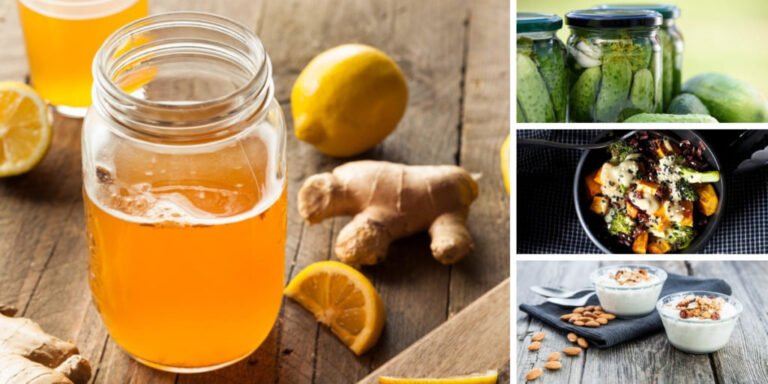Cultures around the world have used fermentation for thousands of years, and each region has its own fermented specialty. From tempeh to kimchi to kefir and beyond, fermented foods have played an important role in our health.
Oh, fermented foods. We love you so, so, so much. And here’s why:
- Fermented foods improve digestion. The fermentation process yields countless probiotics, which help maintain and nourish the microbiome in our guts.
- Fermented foods benefit the immune system. About 70% of our immune system is located in and around our digestive system. When we cultivate the good bacteria in our gut, our immune system also gets a big boost.
- Fermented foods contain important nutrients. Cultured foods are nutritious because they contain more nutrients than their unfermented counterparts. Depending on the type of food, fermentation can increase B vitamins, folic acid, and vitamins K, C, and A (well, hello, antioxidants). Fermentation also reduces phytic acid, a compound that interferes with our digestion.
our favorite fermented foods
Here are some of our favorite fermented foods and how you can incorporate them into your daily diet.
1. Fermented nut cheese
Photo courtesy of Meghan Telpner
There’s nut cheese and then there’s that fermented nut cheese, which takes vegan cheese making to a whole other level. It’s really quite simple to do: soak nuts or seeds, drain them, mix them with probiotic powder, then let the live cultures flourish.
How to enjoy: Spread it on toast or crackers, use it as a vegetable spread, toss it on salads, chili, sandwiches or wraps, or melt it into warm (not hot) soup.
A must-try recipe: Fermented nut cheese by Meghan Telpner

2. Miso
Photo courtesy of Smitten Kitchen
Miso is traditionally made from fermented soybeans, but rice, barley, and even chickpeas can be used as its base (just be sure to read labels, as miso containing barley is not gluten-free). In addition to digestive benefits, miso contains the valuable minerals zinc, manganese and copper, as well as vitamin K for bone building.
How to enjoy: Stir miso into a mug of hot water for instant miso soup or add to sauces, dressings, dips, stews, soups or marinades. Remember that the beneficial bacteria will be destroyed at high temperatures – so never boil your miso! If you are adding it to a hot dish, mix the miso with a little hot water and stir it in at the end of cooking.
Recipe to try: Sweet Potato and Broccoli Miso Bowl by Smitten Kitchen
3. Kombucha

Photo: iStock
Kombucha is made from a mixture of tea and sugar – but don’t worry, the fermentation process eats up all the caffeine and sugar until you’re left with a delicious mix of enzymes, minerals and vitamins (especially B vitamins, which are vital for energy our levels and help manage stress).
Kombucha has become very popular lately and many brands are loaded with added sugars. In some cases, the amount of sugar overshadows the health benefits, so watch out! The kombucha should still taste sharp and sour, with a little sweetness if you’ve added sugar to the mix.
How to enjoy: Kombucha is usually enjoyed on its own (so raise your glass and make a toast), but you can also add it to green smoothies or mix it with fruit and make an alcohol-free margarita.
Recipe to try: How to Brew + Flavor Kombucha by Melissa Torio
4. Dairy-free yogurt
Photo: My Quiet Kitchen
True fermented dairy may be easier to digest than other forms of dairy, however, even with the fermented benefits, many of us are still intolerant. Fortunately, there are many brands of non-dairy yogurt made from coconuts, almonds, soy, cashews, and rice.
You can also try making your own! You also don’t need a fancy yogurt maker: just take your non-dairy milk and mix in some probiotic powder (or pop open a capsule or two). If you have a dehydrator, you can transfer the yogurt mixture in there for 6-8 hours, but you can also leave it out on your counter for a day or two.
How to enjoy: Dairy-free yogurt can be tossed into smoothies, eaten with fresh fruit, nuts, seeds, cocoa nibs or granola, or used as a topping for oatmeal, pancakes, French toast or chia pudding. You can use unsweetened dairy-free yogurt in savory situations as well. Mix it with some herbs and garlic for a delicious dipping sauce or creamy salad dressing, or put it in your chili instead of sour cream.
Recipe to try: Yogurt with almond milk from My Quiet Kitchen
5. Pickles

Photo: iStock
Did you know that you don’t need to use vinegar to make pickles? Is true. All you need is salt and water for the pickling and fermentation process to take place. Most store-bought pickles are packed with white vinegar, as well as cooked and canned, which destroys all the beneficial bacteria.
Cucumbers are a popular pickling vegetable, but basically you can pickle: carrots, asparagus, garlic, garlic, courgettes, pearls, beets, peppers, leeks, radishes – the sky’s the limit! If you can squeeze it into a jar, you can try to pickle it, we say.
How to enjoy: Load up on a fermented vegetable for a quick snack (the salty taste can also kick in sugar cravings), add some to your plate every night, or use them as a topping for burgers and sandwiches.
Recipe to try: How to Pickle by Meghan Telpner
Get the FREE Resource Library with 35+ free resource guides, including a Kombucha & Pickling Guide!
Complete the form below for immediate access.
If you want to start incorporating more fermented foods into your daily diet and want to learn how to make your own, join us at Fundamentals of Fermentation! This mini-lesson will inspire you to get into your kitchen and start creating gut healing, digestive-friendly, flavor-rich, and easy-to-make ferments.




